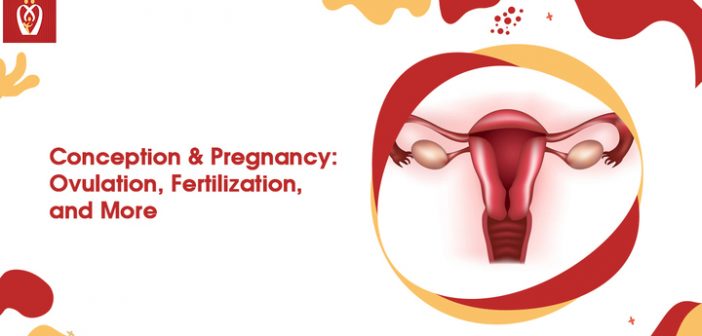conception & pregnancy- Ovulation occurs during the menstrual cycle. It is the release of the egg (ovum) from a woman’s ovary called ovulation.
Follicle-stimulating hormone (FSH) induces the maturation of follicles in one of a woman’s ovaries every month, between days six and fourteen of the menstrual cycle. Only one mature egg develops in each growing follicle from day 10 to day 14. An abrupt increase in luteinizing hormone prompts the ovary to release its egg on day 14 of the menstrual cycle.
The fallopian tube is a small, hollow tube that connects the ovaries to the uterus for five days. Another hormone, progesterone, surges in the body throughout the egg’s journey through the fallopian tube, helping to prepare the uterine lining for pregnancy.
Ovulation
- The pituitary gland, located in the brain, releases a hormone every month. Ovarian follicles result from this hormone telling the ovaries to make many of these fluid-filled cysts. In addition, follicles produce estrogen as they develop. During pregnancy, estrogen helps to strengthen the walls of your uterus.
- On the seventh day of your cycle, all of the follicles, save one, have stopped developing. However, the oocyte (egg) within this follicle continues to develop and increase.
- At twelve days old, the follicle begins to produce an abundance of estrogen into the body. The pituitary gland releases the luteinizing hormone in response to the estrogen reaching the pituitary. This hormone accelerates the follicle’s growth.
- The egg in the follicle separates from the ovary just before ovulation. Follicles begin to emit chemicals that stimulate the fallopian tube to close up on the follicle and encircle it.
- After months of growth, the egg and fluid are released from the follicle, bursting open.
- These tiny finger-like protrusions called fimbriae to sweep over the follicle’s ruptured membrane and pick up the egg.
- To reach the fallopian tube’s opening, the egg must be carried. The uterus is gradually pushed towards the fallopian tube by muscular contractions.
- A fertilized egg will either encounter sperm in the fallopian tube as it travels to the uterus or be absorbed back into the body and expelled from the body.
Conception & Preganancy
- A woman must fertilize her egg within 12 to 24 hours after ovulation to get pregnant.
- During intercourse, a protein-rich transparent jelly coats the top of the vagina due to an increase in estrogen levels right before ovulation. As a result, the vagina becomes acidic. It’s a good place for sperm to thrive, as well. Before an egg is released, the sperm may live in the mucous for up to five days before swiftly swimming towards the cervix.
- There are sticky cells on the egg that make it easier for the fallopian tube to capture it after ovulation. As soon as the egg and sperm come into contact, the sperm breaks down the egg’s adhesive cells. However, it is not enough to have just one sperm penetrate the egg and fertilize it; rather, numerous must connect to the outer shell and membrane of the egg first.
- Chemicals are produced to prevent the entry of more sperm after fertilization to prevent the egg and sperm from merging and dividing to form an embryo fast.
- The fertilized egg divides and migrates toward the uterus over the following four or five days.
- The burst follicle (known as the corpus luteum) secretes the hormone progesterone into your bloodstream, which prepares the uterus for the egg to implant.
- Increasingly powerful signals are being sent to the ovary to enhance and extend progesterone production, essential for the fetus’s survival as the pregnancy develops and implants into the mother’s uterine lining.
- The three to six days before and including ovulation are ideal for trying for a baby. Depending on how long your cycle is, you’ll see different fertile days.
If you are hoping to become pregnant, there are no clear rules on when to discontinue using the pill (oral contraception). Following the pill’s discontinuation, several medical practitioners recommend that you go through three regular menstrual cycles. The time it takes for a woman’s fertility to restore varies from person to person. Pregnancy while using the pill is conceivable but very unusual. There is no evidence to suggest that this is harmful to the unborn child.
